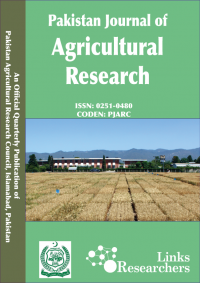CROP RESIDUES AND PHOSPHORUS EFFECT ON YIELD AND ECONOMICS OF DIRECT SEEDED RICE AND WHEAT GROWN UNDER SALINE-SODIC SOIL
Imdad Ali Mahmood*, Arshad Ali**, Armghan Shahzad**, Muhammad Asif Masud Ghumman***, Muhammad Arshad Ullah**, Tariq Sultan** and Badar-u-Zaman**
ABSTRACT
A field study on saline-sodic sandy loam soil (EC =6.6 dS m ; pH e -1 1/2 -1 =8.31; SAR =17.4 (m.mol L ) ; CaCO =3.5% and available P=3.9 mg kg ) was c 3 conducted on direct seeded rice and wheat for two consecutive years at Soil Salinity Research Institute (SSRI) Farm, Pindi Bhattian, Pakistan to investigate the yield and economics of direct seeded rice and wheat under crop residue incorporation and phosphorus applications. Split plot design (crop residue in main plots and P application in sub plots) was followed with three replications. Biomass yields were collected at maturity of each crop. Maximum straw and grain -1 yields of both crops were harvested with the application of P O @ 80 kg ha along 2 5 -1 with crop residues incorporations. Overall 2.75 and 2.89 t ha of paddy and -1 wheat, respectively were obtained with P O @ 80 kg ha under crop residue 2 5 -1 incorporation. Although, the yields produced with the treatment, 80 kg P O ha + 2 5 -1 crop residue, performed similar to P O @ 120 kg ha without crop residues 2 5 incorporation during both the years. However, on average, grain yield of direct seeded rice and subsequent wheat was significantly superior (22 % and 19%, -1 respectively) than that of higher P O application (120 kg ha ) without crop 2 5 residues incorporation. As a whole, constant two years crop residues incorporation further improved the paddy yield (9%) during the following years of crop harvesting. Economic analysis of both the crops was carried out to see the best treatment with sufficient economic benefits as compared to without crop residues incorporation. Maximum net benefit of Rs. 92754 for direct seeded rice -1 and Rs. 69558 for wheat grown with 80 kg P O ha application under crop 2 5 residues incorporation was determined. Among P application treatments under no crop residues incorporation, the maximum net benefit (Rs. 75874 and Rs. -1 -1 =65725) and the highest residual values (Rs. 49809 ha and Rs 39160 ha ) for -1 direct seeded rice and wheat, respectively, were attained with 120 kg P2O5 ha -1 which were not again as much as that of 80 kg P O ha application with crop 2 5 residues incorporation.
To share on other social networks, click on any share button. What are these?






